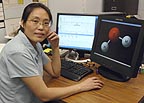August 21, 2007
Researcher wins NSF grant for fuel cell research

Caption follows story
But a Southern Illinois University Carbondale researcher is opening a window to that super small world using computer modeling that can "virtually" bring scientists face to face with chemical reactions at the molecular level.
Lichang Wang, associate professor of chemistry and biochemistry in the College of Science at SIUC, will receive a four-year, $200,000 research grant from the National Science Foundation for her work in "nanostructured fuel cell catalysts with molecularly engineered size, shape and composition." The money will pay for several graduate and undergraduate students, travel and some computer hardware.
Wang will collaborate with a team of researchers from the State University of New York at Binghamton working on catalysts that engineers can incorporate into the design of electric fuel cells for future automobiles and other uses. Using sophisticated software, including some developed at SIUC, she will help the other researchers predict and "see" how different atoms will interact in an effort to help them build the most efficient and effective catalysts.
She will do this through computer modeling and animation, which allows the researchers to test approaches in cyberspace before going to the time, trouble and expense of doing them in a real-world laboratory. Such computer modeling will shave a large amount of time and expense off the researchers' work by cutting down on dead-end formulations and keeping them focused on promising ones.
"It is very difficult and time consuming to make and control the various catalysts in the laboratory, as we're talking about nanoscale structures and controlling variables such as temperature exactly is very important and difficult," Wang said. "But my students and I can make virtual catalysts using the computer relatively easily. We can control variables, like temperature, and we can tell the researchers doing experiments, for instance, whether temperature is a very important variable or not in a particular type, based on our simulation results. This can save lots of time and money."
In the fuel cell research, finding the best catalyst to turn oxygen to water is critical, Wang said. This "oxygen reduction reaction" is one of the research team's main challenges, along with improving membrane conductivity and hydrogen storage and production methods.
Wang uses theoretical calculations to produce animation sequences that show the reactions happening. Researchers can tell from the movements how to make improvements in catalyst formulations. They can also view the reactions from different angles, picking up further clues.
The way the molecules move when stimulated by the light of various frequencies gives the scientists clues on how to break the relevant chemical bonds present. This results in the desired reaction, such as hydrogen production.
"From that perspective, we can actually see what's happening," Wang said. "As we change the variables, the animation changes, too."
With the computer simulations providing pinpoint control over a virtual experiment's variables, the results are more "pure" and reliable to some extent, Wang said. It also makes the research "greener," in that the scientists do not have to use actual chemicals.
"We want to know which direction to go in order to improve the catalysts," she said. "To do this, we run calculations with the computer and examine the simulation details to predict which direction to go."
A secondary aim of the funded research involves improving the SIUC software, making it more user friendly and possibly exporting it to other researchers. Wang also hopes her field of theoretical and computational chemistry becomes more widely used.
"It is a powerful tool that has become more available as computers have gotten better," she said. "What used to take years to compute now takes a few hours."
Caption:
‘Seeing’ the super small – Lichang Wang, assistant professor of chemistry and biochemistry in the College of Science at Southern Illinois University Carbondale, will receive a four-year, $200,000 research grant from the National Science Foundation for her work in “nanostructured fuel cell catalysts with molecularly engineered size, shape and composition.” Wang uses computer modeling that can “virtually” bring scientists face to face with chemical reactions at the molecular level as they pursue catalysts that aid in the production of electricity in fuel cells.
Photo by Russell Bailey
